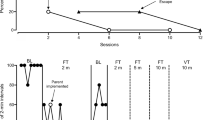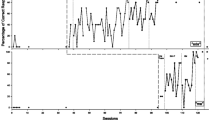Abstract
It has been extremely difficult to teach speech to severely handicapped nonverbal autistic children. However, an overview of the literature suggests the possibility that selecting aspects of motivation as a central target behavior, rather than concentrating on motor speech production per se, may improve the effectiveness of teaching speech to these children. Therefore, the purpose of this experiment was to compare two different reinforcement conditions; one in which successive motor approximations of speech sounds were reinforced; and a “motivation” condition in which attempts to produce speech sounds were reinforced, without any motor shaping of speech. The results, replicated within a repeated reversal disign, showed that reinforcing speech attempts was more effective than reinforcing motor speech sounds with respect to (a) the children's interest, enthusiasm, happiness, and general behavior during treatment; and (b) improvements in the children's speech production. The results are discussed in terms of their relationship to the literature on normal parent-child speech interaction, success and failure, and learned helplessness.
Similar content being viewed by others
References
Barlow, D. H., & Hersen, M. (1984).Single case experimental designs: Strategies for studying behavior change (2nd ed.). Elmsford, NY: Pergamon.
Churchill, D. W. (1971). Effects of success and failure in psychotic children.Archives of General Psychiatry, 25, 208–214.
Dunlap, G. (1984). The influence of task variation and maintenance tasks on the learning and affect of autistic children.Journal of Experimental Child Psychology, 37, 41–64.
Dunlap, G., & Koegel, R. L. (1980). Motivating autistic children through stimulus variation.Journal of Applied Behavior Analysis, 13, 619–627.
Egel, A. L. (1980). The effects of constant versus varied reinforcer presentation on responding by autistic children.Journal of Experimental Child Psychology, 30, 455–463.
Egel, A. L. (1981). Reinforcer variation: Implications for motivating developmentally disabled children.Journal of Applied Behavior Analysis, 14, 345–350.
Fineman, K. R. (1968). Shaping and increasing verbalizations in an autistic child in response to visual color stimulation.Perceptual and Motor Skills, 27, 1071–1074.
Garcia, E. E., & DeHaven, E. D. (1974). Use of operant techniques in the establishment and generalization of language: A review and analysis.American Journal of Mental Deficiency, 79, 169–178.
Goetz, L., Schuler, A., & Sailor, W. (1983). Motivational considerations in teaching language to severely handicapped studlents. In M. Hersen, V. Van Hassett, & J. Matson (Eds.),Behavior therapy for the developmentally and physically disabled (pp. 57–77). New York: Academic Press.
Hewett, F. M. (1965). Teaching speech to an autistic child through operant conditioning.American Journal of Orthopsychiatry, 35, 927–936.
Hollis, J. H., & Carrier, Q. K. (1978). Intervention stategies for nonspeech children. In R. L. Schiefelbusch (Ed.),Language intervention strategies. Baltimore: University Park Press.
Ingram, D. (1976).Phonological disability in children. New York: Elsevier.
Koegel, L. K., & Koegel, R. L. (1986). The effects of interspersed maintenance tasks on academic performance in a severe childhood stroke victim.Journal of Applied Behavior Analysis, 19, 425–430.
Koegel, R. L., Dyer, K., & Bell, L. K. (1987). The influence of child-preferred activities on autistic children's social behavior.Journal of Applied Behavior Analysis, 20, 243–252.
Koegel, R. L., & Egel, A. L. (1979). Motivating autistic children.Journal of Abnormal Psychology, 88, 418–426.
Koegel, R. L., & Johnson, J. (in press). Motivating language use in autistic children. In G. Dawson (Ed.),Autism: New perspectives on diagnosis. New York: Guilford.
Koegel, R. L., & Koegel, L. K. (1988). Generalized responsivity and pivotal behaviors. In R. H. Horner, G. Dunlap, & R. L. Koegel (Eds.),Generalization and maintenance: Lifestyle changes in applied settings (pp. 41–66). Baltimore: Paul H. Brookes.
Koegel, R. L., & Mentis, M. (1985). Motivation in childhood autism: Can they or won't they?Journal of Child Psychology and Psychiatry, 26, 185–191.
Koegel, R. L., O'Dell, M. C., & Koegel, L. K. (1987). A natural language teaching paradigm for nonverbal autistic children.Journal of Autism and Development Disorders, 17, 187–200.
Koegel, R. L., & Schreibman, L. (1976). Identification of consistent responding to auditory stimuli by a functionally “deaf” autistic child.Journal of Autism and Childhood Schizophrenia, 6, 147–155.
Koegel, R. L., & Traphagen, J. (1982). Selection of initial words of speech training with nonverbal children. In R. L. Koegel, A. Rincover, & A. L. Egel (Eds.),Educating and Understanding Autistic Children (pp. 65–77). San Diego: College-Hill Press.
Lovaas, O. I. (1977).The autistic child. New York: Irvington.
Lovaas, O. I., Berberich, J. P., Perooff, B. F., & Schaeffer, B. (1966). Acquisition of imitative speech by schizophrenic children.Science, 151, 705–707.
MacMillan, D. L. (1971). The problem of motivation in the education of the mentally retarded.Exceptional Children, 37, 579–586.
MacMillan, D. L. (1975). Effect of experimental success and failure on the situational expectancy of EMR and nonretarded children.American Journal of Mental Deficiency, 80, 90–95.
Martin, G., & Pear, J. (1978).Behavior modification: What it is and how to do it. Englewood Cliffs, NJ: Prentice Hall.
Mittler, P. (1966). The psychological assessment of autistic children, In J. K. Wing (Ed.),Early childhood autism: Clinical, educational, and social aspects (pp. 145–158). London: Pergamon Press.
Moerk, E. (1972). Principles of interaction in language learning.Merrill-Palmer Quarterly, 18, 229–257.
Rutter, M. (1966). Prognosis: Psychotic children in adolescence and early adult life. In J. K. Wing (Ed.),Early childhood autism: Clinical, educational, and social aspects. London: Pergamon.
Rutter, M. (1978). Diagnosis and definition of childhood autism.Journal of Autism and Childhood Schizophrenia, 8, 139–161.
Ritvo, E. R. & Freeman, B. J. (1978). National Society for Autistic Children definition of the syndrome of autism.Journal of Autism and Childhood Schizophrenia, 34, 235–255.
Schane, S. A. (1973).Generative phonology, Englewood Cliffs, NJ: Prentice Hall.
Schumaker, J. B. & Sherman, J. A. (1978). Parent as intervention agent. In R. L. Schiefelbusch (Ed.),Language intervention strategies. Baltimore: University Park Press.
Skinner, B. F. (1962). Two “synthetic social relations.”Journal of the Experimental Analysis of Behavior, 5, 531–533.
Sloane, H. N., & Macaulay, B. D. (1968).Operant procedures in remedial speech and language/training. New York: Houghton Mifflin.
White, R. W. (1959). Motivation reconsidered: The concept of competence.Psychological Review, 66, 297–333.
Author information
Authors and Affiliations
Additional information
This research was supported by Public Health Research Grants No. MH28210 and MH39434 from the National Institute of Mental Health, U.S. Department of Education (Special Education Program) Research Contract No. 300-82-0362, and a grant from the California Community Foundation.
Rights and permissions
About this article
Cite this article
Koegel, R.L., O'Dell, M. & Dunlap, G. Producing speech use in nonverbal autistic children by reinforcing attempts. J Autism Dev Disord 18, 525–538 (1988). https://doi.org/10.1007/BF02211871
Issue Date:
DOI: https://doi.org/10.1007/BF02211871




